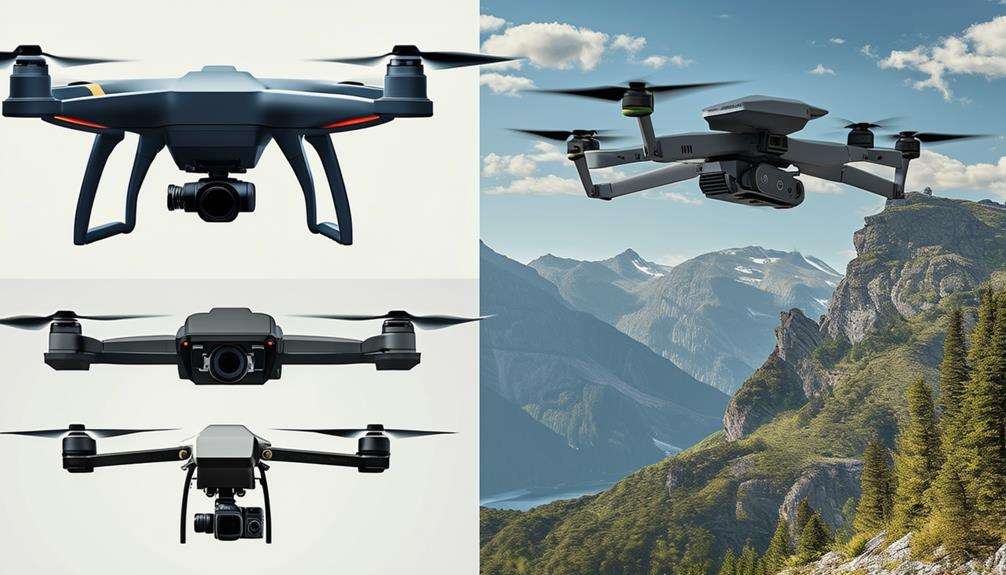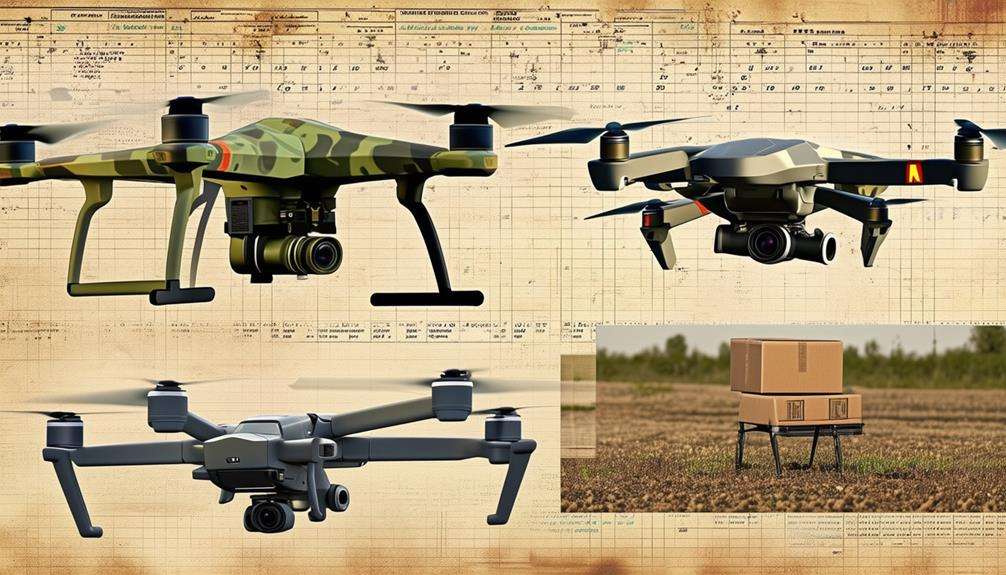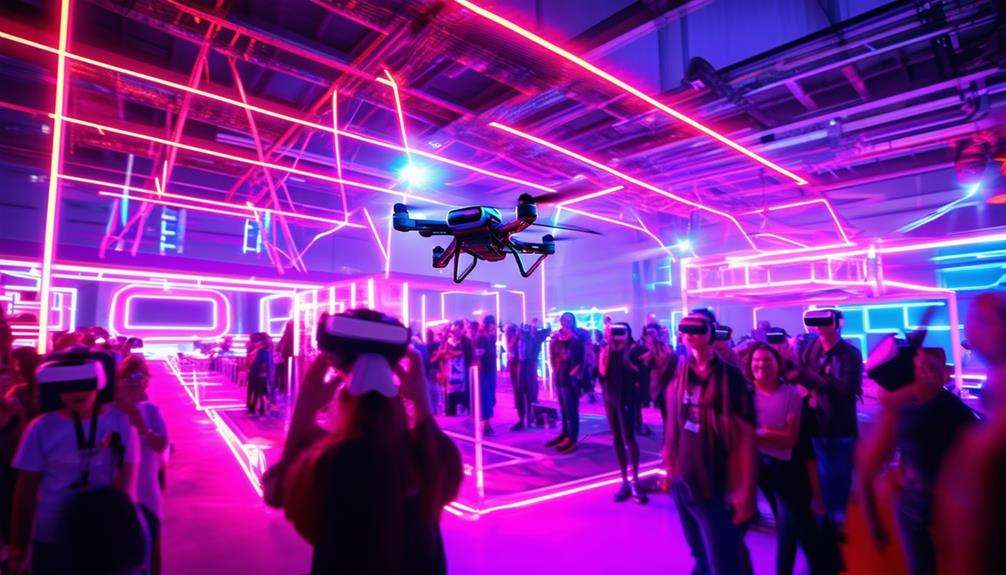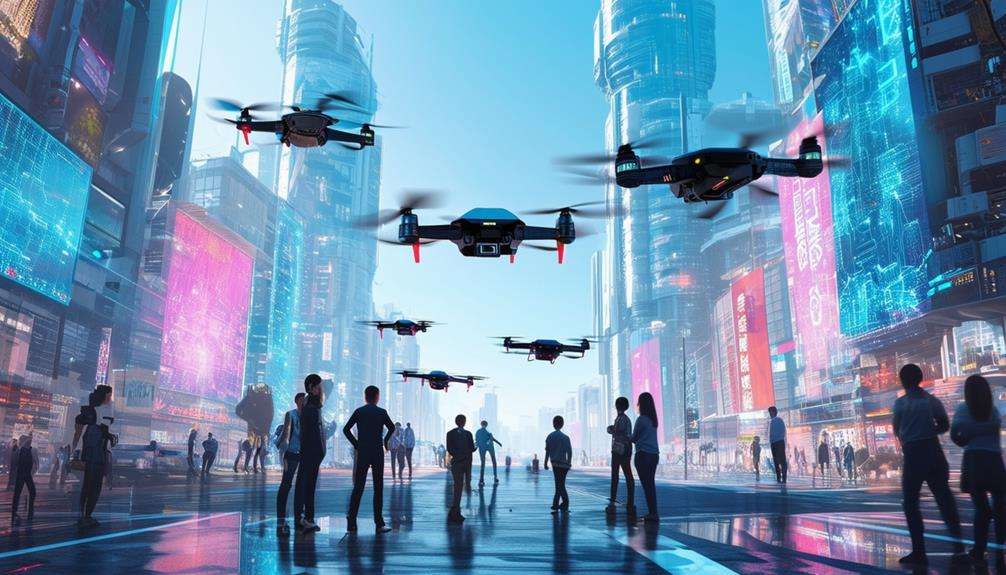The Rise of Consumer Drones: A Historical Timeline
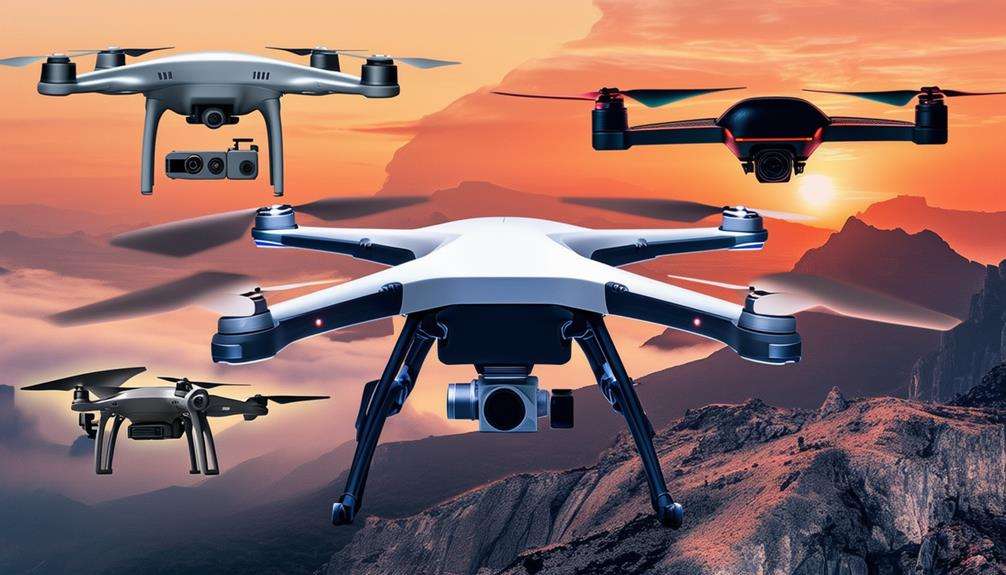
When you consider the rapid rise of consumer drones, it's hard to overlook the pivotal moments that shaped this booming industry. From the groundbreaking Parrot AR Drone in 2010, which pioneered smartphone control, to DJI's Phantom series that democratized aerial photography, the advancements have been revolutionary.
But what truly propelled drones into mainstream use? Investigating how competition, cutting-edge technology, and evolving regulations have influenced this market uncovers surprising twists and turns that have defined the evolution of consumer drones. So, what's the next breakthrough waiting to happen?
Early Beginnings
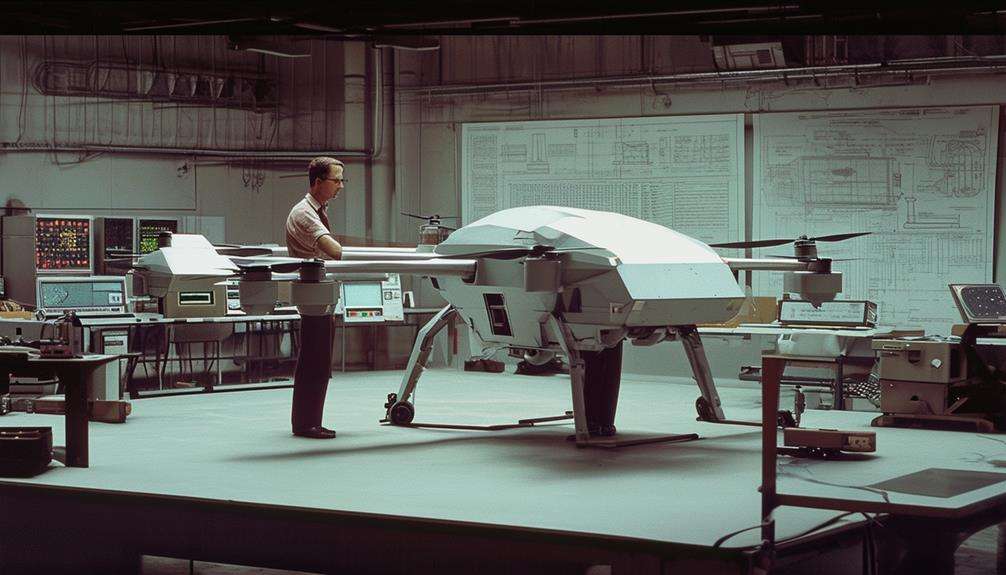
The early beginnings of consumer drones can be traced back to 2010 when Parrot released the AR Drone, making aerial technology accessible to enthusiasts. This marked a pivotal moment in the history of drone technology as it was the first commercial drone designed specifically for the consumer market.
However, it was DJI's launch of the Phantom 1 in 2013 that truly revolutionized consumer drones. The DJI Phantom 1 brought drone technology into the mainstream, offering a ready-to-fly drone with a built-in camera mount. This innovation allowed hobbyists and professionals alike to capture stunning aerial footage with ease.
Following this, DJI released the Phantom 2 in October 2013, featuring significant improvements in flight stability and battery life, broadening its appeal. In June 2013, DJI also introduced the Zenmuse H3-2D gimbal, which enhanced camera stabilization, further elevating the quality of aerial photography.
Later that year, the DJI Phantom 2 Vision was launched, featuring app monitoring capabilities. This made it easier for users to control their drones and view real-time footage, solidifying DJI's dominance in the consumer drone market.
Parrot's AR Drone
In 2010, Parrot revolutionized the consumer drone market with the launch of its innovative AR Drone. This pioneering design was a game-changer, introducing features that were unparalleled in other consumer drones at the time. The AR Drone was among the first to offer smartphone control, enabling users to pilot the drone directly from their mobile devices.
It wasn't just about flying; it also incorporated augmented reality gaming, enhancing the interactivity and enjoyment of the experience. Equipped with a built-in camera and Wi-Fi connectivity, the AR Drone allowed users to stream live video and capture aerial photos with ease. These features made aerial photography accessible to hobbyists and tech enthusiasts alike.
Parrot's AR Drone quickly became popular for recreational use, attracting a broad audience and setting new industry standards. Key features of the AR Drone included:
- Smartphone Control: Pilot the drone using your mobile device.
- Augmented Reality Gaming: Enjoy an interactive flying experience.
- Built-in Camera: Capture live video and photos.
- Wi-Fi Connectivity: Stream video in real time.
- Innovative Design: Set new benchmarks in the consumer drone market.
The success of the AR Drone laid the foundation for future consumer drone models, significantly contributing to the growth of the drone industry.
DJI Phantom Series
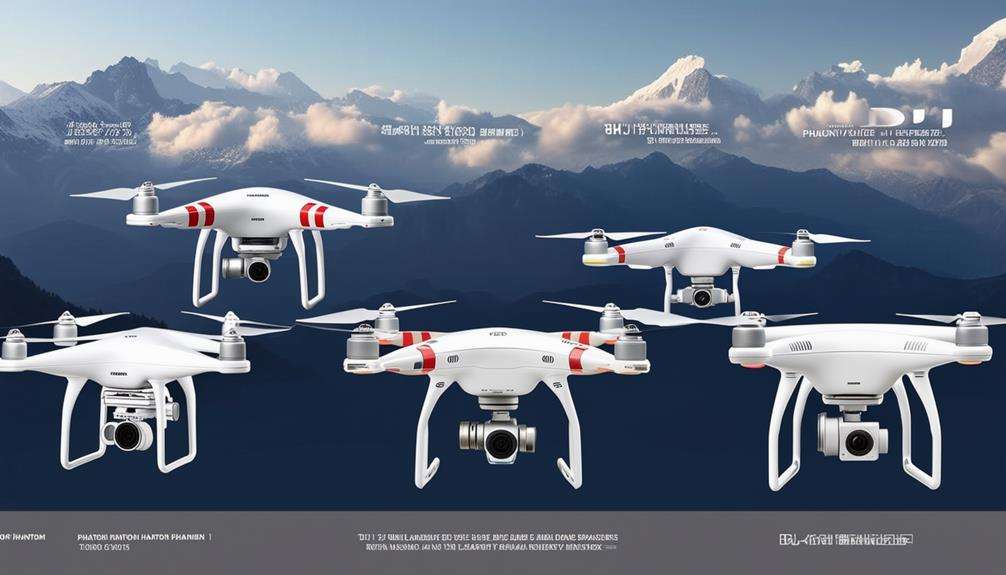
You can't discuss consumer drones without mentioning DJI's Phantom series, which began with the Phantom 1 in 2013. These drones introduced groundbreaking innovations like the Zenmuse H3-2D gimbal and app-based monitoring, setting new industry standards. With each subsequent model, DJI solidified its market dominance, making the Phantom series synonymous with aerial photography.
Game-Changing Innovations
DJI's Phantom series revolutionized consumer drones by making aerial photography accessible to everyone. The Phantom 1, launched in 2013, set the standard for affordable and functional consumer drones. DJI continued to innovate with the Phantom 2, which offered enhanced flight stability and longer battery life, making it easier to capture stunning aerial shots.
A pivotal innovation was the Zenmuse H3-2D gimbal, introduced in mid-2013. This gimbal provided stabilized camera footage, significantly improving the quality of aerial photography. The Phantom 2 Vision further advanced the field by incorporating app monitoring, allowing real-time flight data and control via a smartphone, catering to the growing demand for user-friendly drones.
Key innovations that kept DJI ahead include:
- Enhanced flight stability and extended battery life with the Phantom 2
- Zenmuse H3-2D gimbal for stabilized footage
- App monitoring for real-time flight data with the Phantom 2 Vision
- Transformative body design with the Inspire 1
- Advanced aerial imaging solutions for professionals
These advancements ensured that DJI's Phantom series remained a favorite among both amateur and professional drone enthusiasts.
Market Dominance Achieved
With its groundbreaking features and affordability, the Phantom series quickly established DJI as the leader in the consumer drone market. When the DJI Phantom series launched in 2013, it revolutionized the industry by making high-quality drones accessible to everyday consumers. The initial models, Phantom 1 and Phantom 2, showcased DJI's commitment to innovation and improvement.
DJI's market dominance solidified with the introduction of the Zenmuse H3-2D gimbal in June 2013, which greatly enhanced aerial photography capabilities. This update made capturing smooth, professional-grade footage easier than ever.
The Phantom 2 Vision, equipped with app monitoring, further strengthened DJI's leadership in consumer drone technology. The Phantom 2 Vision allowed users to control the drone directly from their smartphones, offering unprecedented ease and precision.
DJI's SDK program for developers opened up new possibilities for customization and integration, allowing hobbyists and professionals alike to tailor their drones to specific needs. The combination of affordability and advanced features in the DJI Phantom series not only attracted buyers but also set new standards in the consumer drone market. Through these innovations, DJI secured its position at the forefront of the industry.
Crowdfunding Innovations
Crowdfunding platforms have revolutionized the development of drone projects, offering insights into pioneering innovations. Campaigns for products like the Pocket Drone and the Sprite coaxial drone highlight both the potential and challenges of this funding model. These platforms have significantly influenced the consumer drone market.
Game-Changing Funding Platforms
Crowdfunding platforms, particularly Kickstarter, have revolutionized the development and launch of consumer drones. By harnessing collective support, entrepreneurs have secured the necessary funds to bring innovative drone technologies to market, bypassing traditional financing challenges.
Notable examples of crowdfunding in the drone sector include:
- Pocket Drone: Funded on Kickstarter in 2014, initially successful but faced operational challenges and eventually ceased operations.
- Zano Drone: Raised $2.9 million on Kickstarter but ran out of funds in 2015, underscoring the inherent risks of crowdfunding.
- Ghost Drone by Ehang: A successful Kickstarter project in 2015, demonstrating the potential of crowdfunding for advanced drone technology.
- Flexi Drone: Raised $2.3 million across multiple crowdfunding sites, highlighting significant backer interest in drone projects.
- Lily Camera: Achieved $34 million in pre-orders, showcasing strong consumer demand for pioneering drone technology despite eventual skepticism.
Crowdfunding has undeniably transformed funding avenues, enabling entrepreneurs to realize visionary drone projects and paving the way for future innovations.
Pioneering Drone Projects
Groundbreaking drone projects like the Pocket Drone and Ghost Drone have captured public imagination and financial support through modern crowdfunding platforms. The Pocket Drone, funded on Kickstarter in 2014, promised a portable drone solution and gained attention with its creative design. Despite its initial success, the project eventually went out of business, highlighting the inherent risks in pioneering ventures.
Conversely, the Ghost Drone by Ehang, launched in 2015, successfully delivered on its promises, demonstrating the potential for consumer interest in drones. This success showcased how crowdfunding can bring innovative designs to life.
Flexi Drone raised an impressive $2.3 million on various crowdfunding sites, underscoring the growing demand for advanced drone technology. However, not all stories had happy endings. The Zano drone, which amassed $2.9 million on Kickstarter, faced financial difficulties and ran out of funds in 2015. Similarly, the Lily camera drone, despite securing pre-orders totaling $34 million, encountered skepticism and challenges in delivering the promised product. Crowdfunding has undeniably played a pivotal role in the rise of consumer drones, illustrating both the promises and perils of pioneering projects.
Rise of Competitors
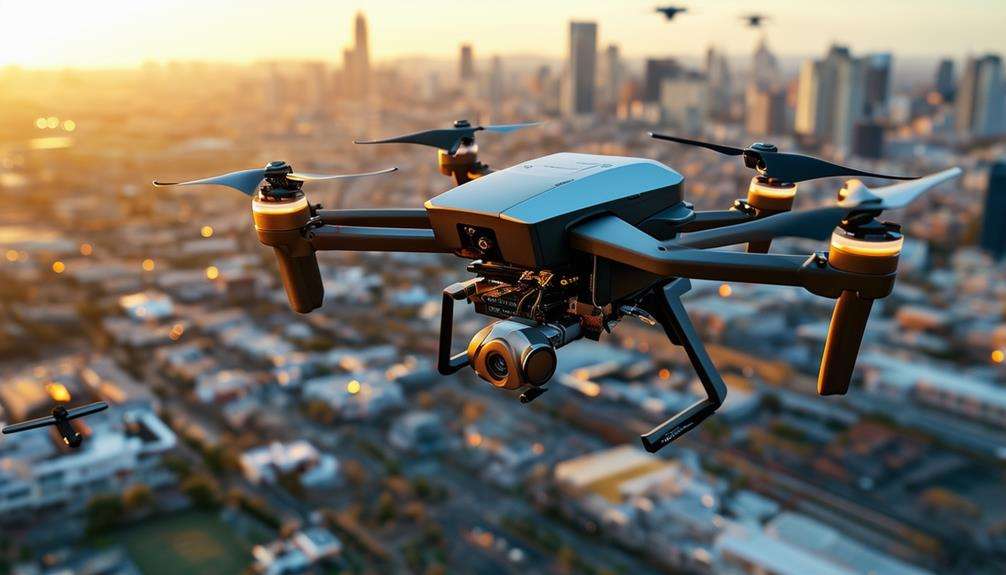
In the expanding consumer drone market, numerous companies have emerged to challenge DJI's dominance by introducing innovative technologies. This intensifying competition is pushing the boundaries of drone capabilities. Despite facing significant challenges and legal disputes, these new entrants aim to establish their presence in the market.
- Pocket Drone: Although initially successful on Kickstarter, this company struggled to sustain operations, underscoring the competitive nature of the industry.
- Lily Camera: Initially lauded for its innovative approach, it faced market skepticism and scrutiny, ultimately leading to its closure.
- Typhoon H: Yuneec's drone, equipped with Intel RealSense technology, introduced advanced obstacle avoidance, drawing attention for its state-of-the-art features.
- Alltel X Star and X Star Premium: These drones offered competitive features at lower prices, posing a challenge to DJI's market share.
- Swellpro's Splash Drone 3.0: This waterproof drone caters to niche markets such as marine and fishing enthusiasts, demonstrating the diversity in drone applications.
These examples highlight the dynamic nature of the consumer drone market, where competition drives rapid technological advancements and market shifts. Each competitor's unique features reflect the ongoing pursuit of innovation in this ever-evolving industry.
Obstacle Avoidance Technology
Obstacle avoidance technology has evolved significantly from its early days with basic sensors to the sophisticated systems we see today. Early drones had limited capabilities, but modern models, such as the DJI Phantom 4, have revolutionized both safety and autonomy. This progression in technology has made flying not only safer but also more accessible to a broader audience. Let's explore these advancements and their impact on drone operations.
Early Development Stages
The introduction of obstacle avoidance technology in the DJI Phantom 4 in 2016 revolutionized consumer drone safety and operation. As the pioneering drone to feature this advanced technology, the Phantom 4 set a new standard in the world of consumer drones. With its ability to detect obstacles and autonomously navigate around them, DJI made flying drones safer and more user-friendly.
Key features of the Phantom 4's obstacle avoidance technology included:
- Real-time obstacle detection: The drone could sense and avoid obstacles in its flight path.
- Autonomous navigation: It could automatically reroute to prevent collisions.
- Enhanced safety: Reduced the risk of crashes, making it suitable for both beginners and experienced users.
- User-friendly operation: Simplified the flying experience, allowing users to focus on capturing stunning aerial footage.
- Industry benchmark: Set a standard for future consumer drones to follow.
This leap in technology marked a significant advancement for consumer drones, making them more accessible and safer for the general public. DJI's implementation of obstacle avoidance in the Phantom 4 didn't just improve safety; it paved the way for more sophisticated autonomous flight features in the industry.
Modern Implementations
Modern drones have significantly advanced from the groundbreaking technology introduced in the Phantom 4, utilizing sophisticated obstacle avoidance systems to ensure safer and more reliable flights. DJI's introduction of this technology marked a pivotal moment in the consumer drone industry. Equipped with sensors such as infrared and computer vision systems, these drones can detect and navigate around obstacles in real-time, preventing collisions and enhancing flight stability.
Today's drones feature multiple sensors and advanced algorithms that improve the precision of obstacle detection and avoidance. This allows drones to autonomously steer clear of trees, buildings, and other barriers, ensuring a safer flight experience. DJI's pioneering efforts in obstacle avoidance technology have set a high industry standard, prompting other manufacturers to incorporate similar features in their models.
Gesture Control Drones
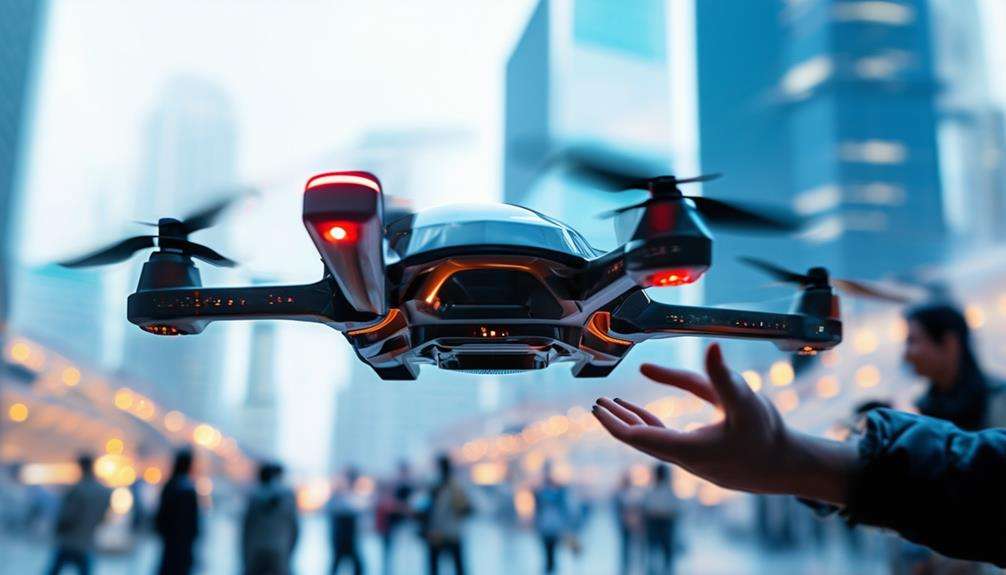
Introducing a new era of hands-free operation, DJI's 2017 release of the Spark drone revolutionized consumer drones with gesture control technology. With the Spark, users could control it using simple hand gestures, making it incredibly user-friendly. This innovation enabled users to take photos, record videos, and navigate the drone with just a wave of the hand. The Spark's gesture control technology provided an interactive flying experience that delighted tech enthusiasts and casual users alike.
The Spark drone's ability to recognize hand gestures meant users could launch, control, and land it effortlessly. This feature made drone flying more accessible and exciting, especially for beginners. Here's why the Spark drone stood out:
- Hands-free control: Navigate and capture moments without touching a remote.
- User-friendly operation: Perfect for beginners with its simple hand gestures.
- Interactive flying: Engage with your drone in a whole new way.
- Convenient launches: Get your drone in the air quickly and easily.
- Innovative design: A leap forward in making drones more accessible and fun.
The Spark drone's gesture control technology set a new standard for user interaction, proving that drones could be both advanced and easy to use.
Regulatory Challenges
Navigating the complex landscape of drone regulation presents significant challenges for both manufacturers and hobbyists. The FAA issued its first commercial drone permit in 2006, a milestone in drone regulation. However, the consumer drone market truly expanded with the release of the Parrot drone in 2010, followed by DJI's Phantom drone in 2013, which made drones more affordable to the public and highlighted the need for clearer regulations.
One of the main regulatory challenges is balancing innovation with safety. The FAA has had to swiftly adapt to the rapid growth of consumer drones by implementing rules that promote their safe and responsible use. These rules include maintaining line-of-sight, adhering to altitude restrictions, and avoiding restricted airspace.
Privacy concerns are also significant, as drones equipped with cameras can easily infringe on personal privacy. For hobbyists, obtaining a drone permit can be complex, requiring knowledge of both local and federal regulations. Manufacturers, too, must stay current with evolving rules to ensure their products meet safety standards. Successfully navigating these regulatory challenges is essential for the continued growth and responsible use of consumer drones.
Mainstream Adoption
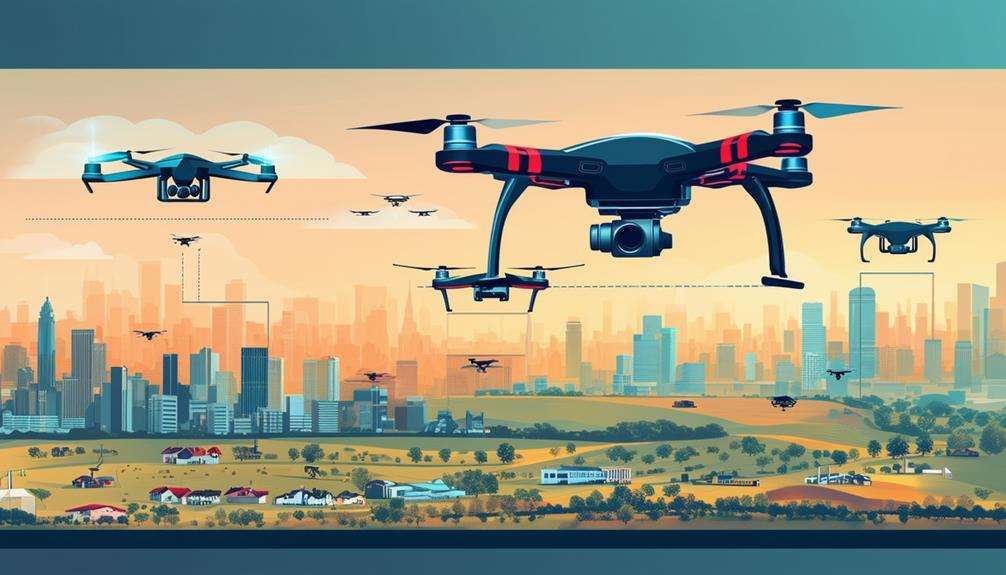
With the advent of regulations, consumer drones rapidly gained traction, marked by the release of the Parrot AR Drone in 2010. Its ease of use and affordability made it widely accessible. DJI soon transformed the market with the launch of the Phantom 1 in early 2013, followed by the Phantom 2 later that year. These models introduced significant advancements in aerial photography and user-friendly features, attracting a broader audience.
DJI's introduction of the Zenmuse H3-2D gimbal in June 2013 was pivotal, greatly enhancing the quality of consumer aerial photography. The Phantom 2 Vision, also launched in 2013, included app-based monitoring, making drone operation even more intuitive. These innovations were crucial in driving the mainstream adoption of consumer drones.
Key milestones include:
- 2010: Parrot AR Drone release sparks consumer interest.
- 2013: DJI Phantom 1 and Phantom 2 launch, increasing popularity.
- 2013: Zenmuse H3-2D gimbal introduction for enhanced aerial photography.
- 2013: Phantom 2 Vision with app monitoring for easier control.
- Collaboration: Early GoPro and DJI partnership influencing market evolution.
These developments marked the dawn of the consumer drone era, making high-quality aerial photography accessible to a wider audience.
Future Trends
The future of consumer drones appears highly promising, with significant market growth and technological advancements poised to transform both recreational and commercial applications.
By 2025, the market is expected to reach $5.6 billion, driven by the increasing adoption of drones for various purposes. Innovations in AI and machine learning are leading the way, enabling more sophisticated autonomous flight capabilities. This advancement will provide safer and more intuitive flying experiences, as drones become more intelligent and responsive.
Drone delivery services are gaining traction, with major companies like Amazon and UPS testing their potential for faster, more efficient logistics. Imagine receiving packages within minutes through drone delivery, revolutionizing how you shop and receive goods. The integration of 5G technology will further enhance this experience by offering real-time data transmission and improved connectivity. With 5G, drones will perform more reliably, even in densely populated urban areas.
Customization is another exciting trend. Future consumer drones will feature modular components and personalized options to meet specific needs and preferences. Whether you're a hobbyist or a professional, these advancements ensure that the drone industry will continue to innovate and adapt to evolving requirements.
Conclusion
Consumer drones have evolved from niche gadgets to mainstream marvels. Starting with Parrot's AR Drone and advancing through DJI's Phantom series, innovation has been relentless. Crowdfunding has spurred creativity, while competitors have continuously pushed boundaries. Gesture control has added a new layer of excitement, although regulatory challenges have also emerged. Today, drones are more accessible and advanced than ever. As technology and regulations evolve, the potential for consumer drones continues to expand.

